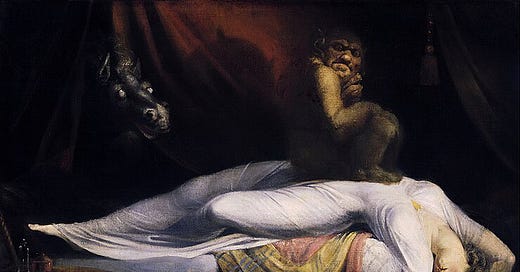Satanic Literature: The Damned by J.K. Huysmans
"The Cult of the Demon is no more insane than that of God."
Joris-Karl Huysmans was a French writer, who achieved literary fame after the publication of his novel À Rebours (Against Nature) in 1884.
Although it received mixed reviews, Against Nature would prove to be influential for a generation of writers, who admired its dandy anti-hero and his ideals.
It is the book which corrupts the protagonist in Oscar Wilde’s The Picture of Dorian Gray:
“For years, Dorian Gray could not free himself from the influence of the book. Or perhaps it would be more accurate to say that he never sought to free himself from it.”
While not as well known, Là – Bas (The Damned) was equally controversial and became infamous for its depiction of a Black Mass.
The novel follows a writer named Durtal, who is researching the life of Gilles de Rais, a companion of Joan of Arc who later became a notorious child-killer and paedophile.
Durtal becomes fascinated by Gilles’s descent into Satanism and his various attempts to conjure the Devil. He begins to neglect the outer world as he delves into the alchemy and witchcraft of the 15th century.
The reader experiences two stories at once, the crimes of Gilles and their effect on Durtal’s mind. The brutal rituals performed by Gilles and his followers are recounted in graphic detail:
“They also cut children’s throats and mixed the blood with ashes to form a paste which, diluted with water, represented the wine of the Eucharist.”
Over the course of the novel Durtal meets various characters, such as Carhaix who lives in a bell-tower. Carhaix represents the moral rigidity of the fin de siècle.
It is when he meets Madame Chantelouve that Durtal begins to become more invested in modern day Satanism. Chantelouve seems to be the embodiment of the New Woman, as she openly meets Durtal despite having a husband at home.
For the character of Madame Chantelouve, Huysmans used the real-life letters of a woman named Henriette Maillat, who was a mistress of another French novelist named Joséphin Péladan. Maillat tried to blackmail Huysmans for the use of her correspondence in the novel.
Durtal goes back and forth on his romantic feelings for Madame Chantelouve, and essentially keeps her around because she can provide access to a Satanic high-priest named Canon Docre.
At various points in the novel Huysmans probes the link between faith, lunacy and mass hysteria. As Gilles continues to abduct massive amounts of children, the French countryside begins to consider that there may be a link between his presence and their dissapperances.
“At first the terrified population tell themselves that evil fairies and malicious genii are causing their children to vanish into thin air, but little by little terrible suspicions are aroused.”
Gilles is eventually caught and put on trial towards the novel’s end. His sentencing coincides with Durtal’s attendance at Canon Docre’s Black Mass.
While certainly blasphemous, the Black Mass pales in comparison to the crimes carried out by Gilles. However readers were shocked by the scenes in which Satan is invoked:
“Lord of Misrule, Dispenser of the Wages of Sin, Master of Venalities and Vices! Satan, we adore thee, God of logic and reason, just thou art!”
Huysmans would continue to be obsessed with the occult for the majority of his life. He held a seance in his apartment a year after the publication of The Damned.
But unlike Durtal who declared that “Christianity is chock-a-block with dogmas which I am unable to swallow and that puts me off.” Huysmans had a change of spiritual heart, which was reflected in the two books that followed The Damned.
En Route and La Cathédrale recount Durtal’s and in turn Huysmans’s conversion to Catholicism. One of Huysmans’s dying requests was that he be dressed in the robe of the Order of the Benedictine Monks.
Perhaps like Durtal he believed that “Faith is the breakwater of the soul. It provides the only haven in which a rudderless man can find peace.”




